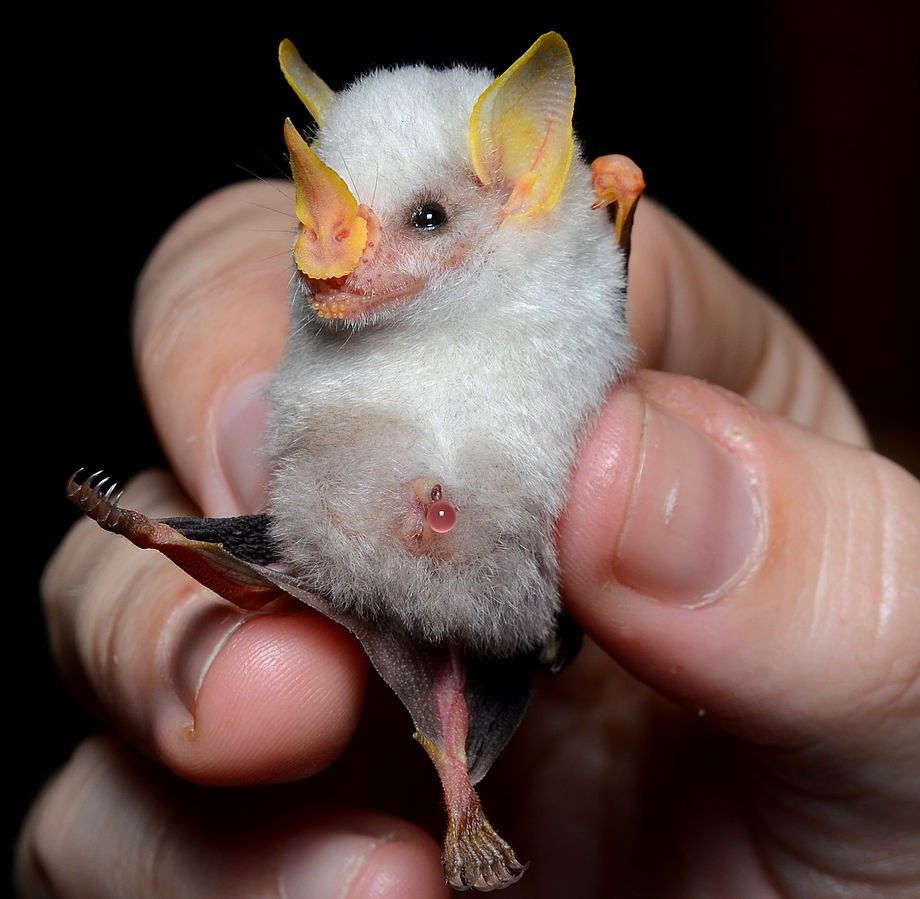Not a Rat but a Bat? The Stunningly Unique Honduran White Bat with a Pig-like Nose

Introduction to the Honduran White Bat
The Honduran white bat (Ectophylla alba) stands out among over 1,300 bat species worldwide due to its striking white fur and bright yellow pig-like nose and ears. Unlike typical bats with dark fur, this species has a soft, pure white coat with grayish underparts and vivid yellow facial features caused by high concentrations of carotenoid pigments, especially lutein. These pigments not only give the bat its unique coloration but also serve as antioxidants protecting it from UV damage.
Physical Characteristics and Size

Measuring only 3.7 to 4.7 cm in body length and weighing between 4 to 7 grams, the Honduran white bat is tiny enough to rest comfortably on a human finger. Its large, triangular nose-leaf and bright yellow ears distinguish it clearly from other bats. The black wings contrast sharply with the white fur, making it a visually remarkable species.
Habitat and Distribution
This bat species inhabits lowland tropical rainforests in parts of Central America, including Honduras, Nicaragua, Costa Rica, and western Panama. It prefers areas rich in heliconia plants, whose large leaves the bats ingeniously modify to build protective 'tents' for daytime roosting. These tents shield them from rain, sun, and predators, and the filtered sunlight through the leaves makes their white fur appear green, camouflaging them effectively.
Unique Behavior: Tent Making
The Honduran white bat is famous for its tent-making behavior. Both males and females cut the veins of heliconia leaves so that the leaves fold into upside-down V-shaped shelters. These tents are usually shared by small groups of 4 to 8 bats, providing communal protection. The shaking of the leaf tents alerts the bats to approaching predators, allowing them to escape quickly. This behavior is rare and fascinating among bats, highlighting their adaptability and social nature.
Diet and Lifestyle
Unlike the common vampire bat stereotype, the Honduran white bat is a strict frugivore, feeding mainly on fruit, seeds, and flowers. It is nocturnal, resting under its leaf tent during the day and emerging at night to forage. Its diet and small size reflect a specialized ecological niche within the rainforest ecosystem.
Conservation Status and Threats
The International Union for Conservation of Nature (IUCN) reclassified the Honduran white bat as Near Threatened in 2023. The primary threat is habitat loss due to deforestation and the decline of heliconia plants, which are critical for their tent-making. Their limited range in Central American lowland rainforests makes them vulnerable to environmental changes and human activity.
Scientific and Cultural Insights
The bright yellow coloration due to carotenoid accumulation is unique among mammals and is being studied for insights into human eye health, particularly macular degeneration. The sexual dichromatism observed—where males have brighter yellow nose-leaves than females—suggests that nose color may play a role in mate selection, offering a rare example of visual signaling in bats.
Community and Media Attention
Recent articles and blogs have highlighted the bat’s unusual appearance and behavior, sparking fascination among wildlife enthusiasts and conservationists. Online communities such as Naver and YouTube channels like KBS Animal TV have shared videos and images, praising the bat’s cute and unique traits while raising awareness about its conservation needs.
Conclusion: A Marvel of Nature
The Honduran white bat is a remarkable example of biodiversity, combining unique physical traits, ingenious behavioral adaptations, and ecological importance. Protecting its rainforest habitat is crucial to preserving this extraordinary species that looks like it stepped out of an animated fantasy yet plays a vital role in its ecosystem.
Discover More

Gyeongpo Beach Opens with Quadruped Robot Guidance and Safety Measures in Gangneung
Starting June 28, Gangneung's 18 beaches, led by Gyeongpo Beach, open with themes of healing and safety, featuring a quadruped robot to provide guidance and safety alerts, plus festivals and advanced rescue technology.

Highly Pathogenic Avian Influenza Detected at Seosan Duck Farm: 28,000 Ducks Culled Amid Emergency Response
On June 14, 2025, a highly pathogenic avian influenza (H5 subtype) antigen was detected at a duck farm in Gobuk-myeon, Seosan, South Chungcheong Province, leading to the culling of approximately 28,000 ducks and strict quarantine measures within a 10 km radius to prevent further spread.